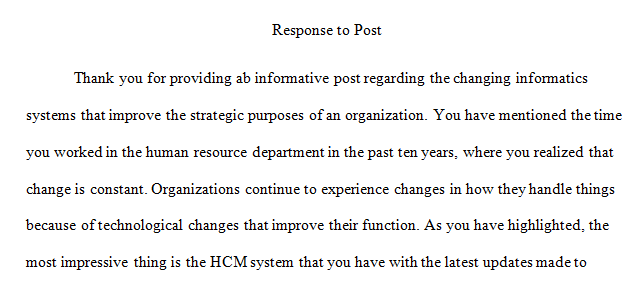
understanding how businesses use information technology effectively
Response to Post
From instructor……..
Before participating in the Week 1 Discussion, Everyone should watch the short video What is an Information System? This will help develop a common understanding of information systems.
As mentioned in this week’s reading, Introduction to Information Systems (Week 1 Content), understanding how businesses use information technology effectively is a critical skill in today’s business world. Often a position is established for the role of a business analyst, which may reside either within a functional department or the Information Technology (IT) department. Throughout this course, you will be approaching a Case Study and series of staged assignments from the role of a Business Analyst in the IT Department. Think of the business analyst role as the liaison between a functional department and IT who helps analyze business processes, gather requirements from key stakeholders, and identify technology solutions to benefit the business. Aligning technology solutions or information systems to help the organization achieve its business strategy is an important part of maximizing the investment in IT.
To help you understand this role and the importance of information systems, this week’s discussion focuses on analyzing how a business uses an information system for STRATEGIC purposes. Each member of Group 1 should do some research, or draw from his or her own experience, and tell us about a company that used an information system for STRATEGIC purposes. Please be sure to tell us what the strategy was that they were working toward. There are many examples in the Course Content reading, but our discussion will be much richer if you select something that is not covered there. Be sure you’re not just discussing their business strategy but also including the use of information systems to enable that strategy. Searching on a company’s mission and strategic goals can help you align the pieces.
To sum up, every post (initial post or reply) should be supported by relevant information rather than simply express an opinion. Prove your point by a) citing external research, b) citing readings from the class content, or c) providing detailed examples of personal experiences that are relevant and support your position on the topic. Be sure to read the instructions and the grading rubric for classroom discussions and participation that is posted at the top of the Weekly Discussions forum. These instructions remain visible throughout the 8 weeks.
Students responsible for replying: Replied to a minimum of three classmates’ postings by Sunday midnight Eastern Time with substantive relevant postings, adding value to the discussion, incorporating relevant research correctly, and demonstrating student’s understanding of the concepts.
Reply to this…300 word min
As I highlighted in my introductions, I’ve worked in Payroll and HR for the past 10 years. In that time, the one thing I had to learn quickly was that change is constant. Drastic changes in the market caused by new trends or demands, cause a consistent need for upgraded talent and systems to maintain the demand. In my line of work, there’s always the “latest-and-greatest” HCM or Time & Attendance system on the horizon. All of them have there advantages, and equal number of disadvantages. However, I have not been more impressed with an HCM system than I have with the latest updates made to Workday.
My company is currently going through the discovery phase of finding a new HCM system that will support the various needs of our global organization. Workday was one of the companies selected for product demo. There were quite a few features that I found quite interesting. Like the ability for employees to use a talk-to-text feature within the mobile modules which will allow them to request time off. That really speaks to how innovative Workday is; to incorporate the ability to fulfill what may be a departmental requirement (time off requests) into what has now become an everyday function (mobile-phone usage). This can defiantly be recognized as something that will improve the employee experience and move companies away from antiquated practice, such as paper leave forms.
Another impressive feature that was demonstrated was the IVR “Call-out” functionality. Much like in any industry, certain jobs require certain talent, and at times that talent is very hard to come by. But when the required talent is suddenly unavailable to complete a job (i.e., call ins, schedule conflicts, labor restrictions, etc.) there is a huge strain placed on the business to fill that quickly fill that spot. That would mean that an Time Admin or a Manager would have to call individual employees (hopefully from a pre-populated list of capable workers) in an effort to find someone to fill the spot. Also with the tedious manual effort to locate an alternate worker, if the same person is often picked in situations like this, it will leave to “worker fatigue” which can come with any number of ramification to the employee and/or the business. Workday was able to demonstrate how its IVR Call-Out capability combined Time & Attendance with LMS to accurate locate the the right person (s) for the job, and simultaneously send call the individuals at once. When the workers receive the call, they are greeted with a pre-recorded message of the what’s needed, time, and place, and they could simply press 1 to accept the job or 2 to decine. Now that’s dope!
Simply put, the strategy that Workday introduces with this feature alone, gives organizations to tools needed to stay compliant in an every changing market.
3 hours ago
REQUIREMENTS
UMGC
Computer Science
Response is needed for the bolded portion
Answer preview……………

apa 374 words